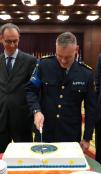Visit to the UNESCO World Heritage Site Babylon

EUAM Iraq Head of Mission Dr. Markus Ritter visited the ancient city of Babylon and met with the Head of the Babylon museum Mr. Mohammed Tahir.
The city, situated 85km south of Baghdad was declared as a UNESCO World Heritage Site in July. Iraq had been lobbying since 1983 for the 4,000-year-old site to be added to the list. The capital of the Neo-Babylonian Empire was famous for its Hanging Gardens, which were among the Seven Wonders of the Ancient World. The site includes villages and agricultural areas, walls, gates, palaces and temples surrounding the ancient city. Visitors are also able to see the famous Lion of Babylon as well as parts of the original Ishtar Gate.
Babylon has suffered in recent years and is in extremely vulnerable condition. Saddam Hussein built a replica palace in the city. US-led military forces crushed ancient pavements with their vehicles and filled sandbags with material that included archeological fragments.
- UNESCO is working on a 5-year plan to start the restoration of the site. Iraqi government has committed funds for the project as well. 85-90% of the city has still not been discovered, Mohammed Tahir says.
Tahir praises the uniqueness of Babylon as the birthplace of human civilisation.
- Arabic language was born here. Iraqis still follow the same customs than back in the Babylonian times, such as the foold culture.
During his visit Dr. Ritter met also with the Police Chief of the area, Brigadier General Awadi and discussed the security situation in Babylon.
- Thousands of tourists have already visited Babylon and the aim is to boost tourism in the city. 167 police officers are securing the area. Out of them 30 have been trained on protection of cultural heritage.
EUAM Iraq as part of its mandate continues to work actively on protection of cultural heritage, such as preventing illicit trafficking of cultural property.

| VastaaLähetä edelleen |





